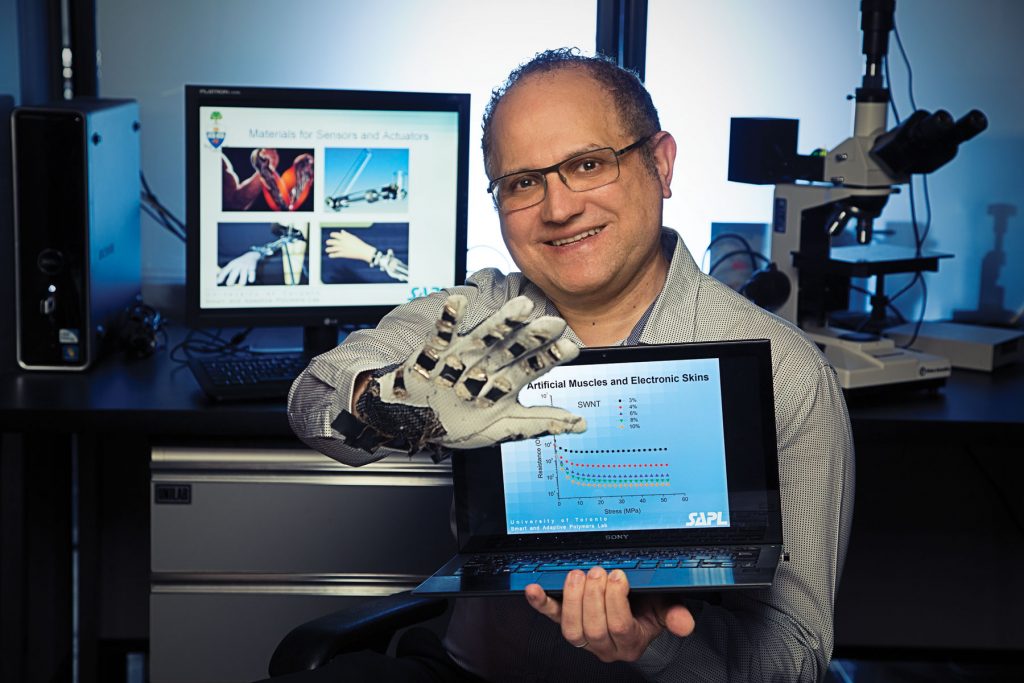Professor Hani Naguib’s smart materials group is building artificial muscles, electronic skins and an array of other cool products
[sharexy]

June 5, 2015 | By Jenny Hall
—Originally published in the Spring 2015 issue of U of T Research’s Edge magazine
In 1999, NASA issued a challenge to the scientific community: to develop a robotic arm with artificial muscles that could beat a human in an arm-wrestling match.
At a conference six years later, a high school girl faced off against three such arms. She won against each of them, but the scientific gauntlet was thrown down — and an idea was planted in Hani Naguib’s mind. A professor of mechanical and materials engineering, Naguib’s attempt to make an artificial muscle is part of his interest in smart and adaptive materials.
While previous generations of artificial muscles were made with motors, Naguib’s uses very fine, lightweight fibres that contain “memory material.” He can train his material to “remember” certain shapes.
“A smart material senses and responds to the environment,” he explains. “For example, if it senses heat, it could respond by cooling the environment. Or by sensing something in its environment, it might change its own shape.” Take the muscle. While previous generations of artificial muscles were made with motors, Naguib’s uses very fine, lightweight fibres that contain “memory material.” He can train his material to “remember” certain shapes. When he activates a small electrical charge, the material moves into a shape it has been programmed to remember — a hand making a fist, for example.
All of Naguib’s work is based on a deceptively simple principle—exploiting the existing properties of materials.
“Imagine if I put rubber in the freezer,” he says by way of analogy. “It would become really stiff. I could take rubber and make into any shape I want. If I put it in the freezer, it will retain that shape.”
Of course, Naguib’s lab isn’t full of rubber balls and freezers. He and his team work with nano- and micro-structures, eventually scaling up to build prototypes when they have a hit.
Some of the lab’s recent projects include:
- Smart wearables that have sensing and battery-like capabilities
- Electronic skin that is self-healing (ultimately for going over those artificial muscles)
- Stents and surgical tools that are inserted in a patient as a thin wire and then open once they’re in place, making the surgical implantation less traumatic
- Sponge-like materials for drug delivery that “squeeze” and release liquid drugs when they’ve reached the right spot in the body
Where do these varied applications come from? Naguib says that while in the past labs like his would build something and then think about how it might be applied, today he has reversed the process. He actively seeks out problems to solve, talking to people at hospitals and in industry about how his lab could help them.
This problem-based method is also at the heart of the Toronto Institute for Advanced Manufacturing, which Naguib directs (see below).
“The idea is to bring research all the way to final products that have impact,” he says. “We’re looking to make long term benefits to society.”
About the Toronto Institute of Advanced Manufacturing (TIAM)
What?
Founded in 2014, this multidisciplinary institute at U of T Engineering is focused on:
- Manufacturing of advanced materials: making new and better materials
- Advanced processes and systems: improving manufacturing processes
- Knowledge-based manufacturing: handling data better and applying mathematical tools to manufacturing.
How?
By collaborating with industry to solve real problems. Researchers have collaborated with Magna International, Celestica, Blackberry, Pratt and Whitney, Bombardier and GE Digital Energy. TIAM also supports research and development for small- and medium-sized enterprises and startup companies.
Why?
To create long-term benefits to society. Advanced manufacturing creates jobs at the same time it produces value added, greener products that improve health and quality of life.